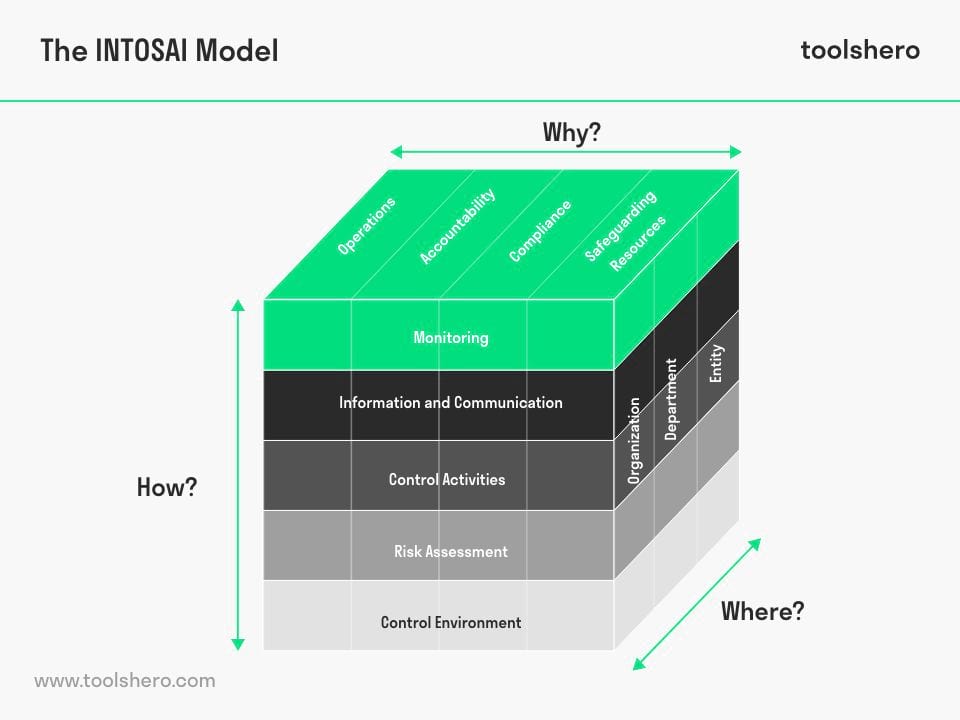INTOSAI (International Organization of Supreme Audit Institutions)

INTOSAI: In this article, you will find a practical explanation of the International Organization of Supreme Audit Institutions (INTOSAI). It covers what the INTOSAI is, what its objectives are, what its auditing standards focus on and what its code of ethics is. It furthermore touches on various definitions and explanations of quality management and provides an overview of the INTOSAI model. After reading this article, you will understand the basics of this powerful concept.
What is INTOSAI?
INTOSAI is the International Organization of Supreme Audit Institutions. It was created in 1982 and brings together national audit institutions (NAI) from all regions of the world, except for Africa, which has its own organization (AFROSAI).
Management of the INTOSAI is the responsibility of an Executive Committee, composed of a president and four vice-presidents who are elected by direct ballot by the national members at Congress. The Executive Committee elects a Secretary General, a Treasurer and a N°2, for a three-year mandate renewable once.
In addition to these senior posts, three regional coordinators are appointed: one each for Europe, Asia Pacific and Americas.
Their main activities are: organizing congresses, technical assistance to NAIs in the area of public sector auditing and training, monitoring NAI performance through peer reviews, developing standards for public sector auditing, promoting awareness of the importance of good governance and providing a platform for cooperation among NAIs.
It is also responsible for two permanent organs: The Permanent Committee (PC) composed of 18 members with 6 rotating seats which are assigned by region every second year. Second is the Task Forces, which are constituted every three years to study specific subjects in coordination with experts from different countries.
Objectives INTOSAI
INTOSAI has three main objectives:
- To promote the role and mission of NAIs
- To develop and strengthen cooperation between NAIs
- To promote the exchange of knowledge and experiences among NAIs
Thus, INTOSAI is an international institution whose mission is to increase cooperation between supreme audit institutions around the world by sharing experiences and exchanges related to quality management.
Quality management
INTOSAI has been working with quality practices since 1990 when it began with ISO 9000 series registration. In 2009, INTOSAI decided to update this work and follow new developments in quality field. In 2010, a Task Force on Quality Management was created which developed an INTOSAI Guidelines on Quality Management System for Supreme Audit Institutions (INTOSAI GAQM). The major goals of the task force were:
- Setting up a framework for improving the quality management system of NAIs
- Presenting a roadmap for developing a QMS (Quality Management System)
- Reviewing existing policies and practices of different audit institutions from across the world with regards to their vision on quality
Auditing standards of INTOSAI
The auditing standards of INTOSAI focus on:
- The development and application of appropriate tools
- Encouraging cooperation between NAIs
- Developing and strengthening exchanges and training
INTOSAI promotes the use of quality audits that are compliant with international standards. It also emphasizes on promoting dialogue between NAIs that are undertaken owing to their different levels of development.
Furthermore, INTOSAI encourages the exchange of knowledge for long term benefits in terms of developing audit capacity among its members. The working group defines universal criteria for identifying risks and vulnerabilities related to audit quality management while taking into account national characteristics.
Code of ethics on INTOSAI
INTOSAI has also adopted a code of ethics. The INTOSAI code of ethics includes:
- Dignity
- Integrity
- Objectivity
- Professional competence and independence
- Transparency
The INTOSAI encourages its members to conduct audits according to this code of ethics to ensure the quality of their work
Dignity
The first principle of the code of ethics is the notion of dignity. The INTOSAI invites its members to respect individuals involved in audits and ensure that they do not face any kind of harassment as a result of their work.
INTOSAI has set up a mechanism which can be used by NAIs members to bring forward accusations or allegations through an ethics hotline and case management system.
It is important to highlight that this code of ethics does not aim to replace existing national laws and rules regarding ethical behavior but rather, it has been designed as a complementary tool for audit quality management at both individual and organizational levels.
Integrity
The second principle of the code of ethics is the notion of integrity.
INTOSAI has developed a clearance system for its members to make sure that they are not involved in audits which would violate the INTOSAI Code of Ethics. The clearance system was created under the framework of INTOSAI Code of Integrity with Entry and Exit Clearance requirements.
Professional competence and independence
This section highlights that audits must be conducted by qualified personnel who act impartially without any conflicts of interest.
The INTOSAI encourages its members to provide training for their staff so as they can fulfill international standards regarding professional competence and independence expectations.
Transparency
Transparency is an important pillar in the auditing process, especially when it comes to interacting with the auditees. Members must adopt a clear and honest communication with the auditee and should provide all information needed for an audit to be conducted properly.
There should be no discriminations as a result of language, sex, race or religious beliefs. Transparency is also necessary when it comes to communicating the results of an audit back to the auditee, as well as other NAIs who might take part in such audits. The code of ethics encourages openness and fairness between all parties involved.
INTOSAI Monitoring and Certification System (IMCS)
The IMCS was created by INTOSAI Executive Committee in 2011 to address two main objectives:
- To promote quality management systems
- To develop a set of certification process tools to improve the quality of audits in countries undergoing national reforms
The IMCS consists in a standard procedure that can be used by NAIs when conducting an audit. The purpose is to have a common understanding on what needs to be done during an audit, including the structure of reports that are presented at the end of an audit. This system allows for transparency and continuity within audits conducted across different countries.
INTOSAI Internal Audit Checklist (IIAC)
The IIAC was implemented following requests made by NAIs who wanted INTOSAI to develop a self-analysis checklist for its members under two main objectives:
- To make sure that it provides useful guidelines for developing internal audit activities
- To ensure that INTOSAI can monitor its own activities
The Audit Checklist is divided into two main sections:
- Introduction, where guidelines are given on how to complete the checklist
- Audit questionnaire, which consists of a series of questions to be answered by NAIs
Priority areas for improvement are highlighted at the end of each question. The IIAC should be used as a self-assessment tool and is not intended to substitute audits conducted by NAIs but rather, it has been designed to help them improve their internal audit process.
INTOSAI Monitoring System (IMS)
This mechanism was implemented following requests made by NAIs who asked the INTOSAI to develop a system which would monitor the data entered into their information systems.
The Monitoring System involves three main procedures:
- The monthly questionnaire allows NAIs to collect some financial and non-financial data, for example on membership fees, training, INTOSAI meetings etc.
- The survey of changes in national legislation is sent out every year at the end of May
- Each year at the end of November NAIs are required to submit their budget for approval
Overall, the IMS was designed to provide more accurate information about INTOSAI activities.
Quality management in SAIs: what is it?
According to INTOSAI 2013 Quality Management Manual, “quality management is a process for ensuring that resources are used effectively, efficiently and economically in order to meet the needs of users while taking into account the state of technology.” That incorporates all aspects of an organization’s activities, including working methods, personnel training, economic efficiency, etc.
INTOSAI requirements on quality management applied by SAIs?
INTOSAI has encouraged NAIs to ensure that their actions are in line with the international standards in terms of quality management. The INTOSAI Quality Management Manual is intended to encourage its members to improve the quality of their audits, thus strengthening internal control systems.
The INTOSAI states that “quality management covers all aspects of work carried out by an SAI” and recommends NAIs to have a system where they can monitor all risks. Furthermore, it also claims that NAIs should have procedures for identifying these risks so as to provide assurances about whether they are being properly managed.
Beyond this claim, however, there is no explicit requirement that SAIs need to adhere to specific procedures or controls in order to comply with the INTOSAI’s Quality Management Manual.
INTOSAI model: the main components
Having dealt with various definitions and explanations of quality management, we now move on to the INTOSAI model. The organization uses a four-dimensional model, which covers all aspects of audit activity:
- Planning
- Conducting
- Reporting
- Monitoring and improving

Figure 1 – INTOSAI Model
Planning
The INTOSAI recommends to draft a quality management plan. The plan should include the participation of all audit staff and should be communicated to all members of the organization. It also states that there is no need for such a plan if their organization does not have any SAIs or if it processes only simple audits without any risks.
Conducting
INTOSAI requires its member organizations to take an interactive approach when conducting audits so as to promote dialogue and cooperation with other NAIs and stakeholders within the country’s government during the process.
That has been referred to as “increased engagement.” They also encourage high standards in terms of independence and impartiality, while recognizing that it is normal for SAIs’ staffs to become familiar with the organizations they audit.
The INTOSAI claims that it is of utmost importance for NAIs to keep updated by attending training and conference courses on new developments in the field so as to improve their professional skills.
Furthermore, it recommends an appropriate ratio of experienced and inexperienced auditors within any given audit team so as to ensure sound audits and good quality management practices.
It also states that quality management requires SAIs to define when a member of staff has reached full proficiency in terms of carrying out audits. In line with this requirement, they encourage that an assessment system should be set up for all members of staff which ensures that there are no skill gaps or weaknesses throughout the organization’s workforce.
Reporting
INTOSAI recommends standardizing reports and, where possible, making them available electronically (through the Internet). They also claim that such a measure could help promote transparency and improve public trust in SAIs.
Monitoring and improving
INTOSAI requires its members to monitor all aspects of their audit activity on an ongoing basis to ensure consistency and best practice. Moreover, it claims that there should be regular internal reviews throughout the year and external reviews at least once every four years.
As for improvement, INTOSAI suggests their member organizations carry out audits on themselves whenever necessary to evaluate processes within the organization’s workforce.
Such an approach is intended to enhance performance by identifying opportunities for continuous improvements.
These are just some examples of how the INTOSAI deals with quality management. There are other areas, such as communication and change, where they make recommendations to their members about how they should carry out these efforts.
Now It’s Your Turn
What do you think? Do you think INTOSAI gives value in quality management to companies? Do you have any suggestions or something to add?
Share your experience and knowledge in the comments box below.
More information
- Saar, T. (2012). Environmental Auditing in INTOSAI: 20 Years Later. International Journal of Government Auditing, 39(3), 1.
- Azuma, N. (2008). The framework of INTOSAI Government Auditing Standards: in the stream of international convergence. Government Auditing Review, 15, 77-97.
- Ånerud, K. (2004). Developing International Auditing Standards: Cooperation between INTOSAI and the International Federation of Accountants. International Journal of Government Auditing, 31(4), 20.
How to cite this article:
Ospina Avendano, D. (2022). INTOSAI (International Organization of Supreme Audit Institutions). Retrieved [insert date] from Toolshero: https://www.toolshero.com/quality-management/intosai/
Published on: 03/08/2022 | Last update: 12/15/2022
Add a link to this page on your website:
<a href=”https://www.toolshero.com/quality-management/intosai/”>Toolshero: INTOSAI (International Organization of Supreme Audit Institutions)</a>












